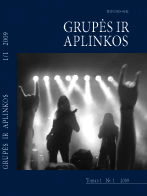Atliekų rinkėjų subkultūra
Subculture of the Dump
Author(s): Donata PetružytėSubject(s): Cultural Essay, Political Essay, Societal Essay
Published by: Vytauto Didžiojo Universitetas
Keywords: atliekų rinkėjai; pakartotinis atliekų naudojimas; etnografinis tyrimas; waste pickers; scavengers; ragpickers; recycling; ethnographic research
Summary/Abstract: This paper presents the results of the research which was conducted in the Kariotiškės Garbage Dump in 2006-2008. Research method: visual ethnography. Research was conducted in collaboration with Mindaugas Survila, a film maker and operator. Collected data: field notes, photos, audio and video tapes, etc. Research participants: about 30 people who worked and lived in the Kariotiškės Dump during its closing. A few general features of life in the dump are briefly introduced by the author: Work. Work there entails picking trash (metals, glass and plastic) and selling it to “recyclers”. What attracts people to the dump? (1) The possibility to earn fair money. (2) The possibility to find useful things. (3) The possibility to be successful and have special findings. Income. It depends on 4 factors: age, sex, work and success. The average income of the dump people can vary from a few tens to a few hundreds of litas per day. Housing. There are some several types of typical houses or slums. Construction: (1) houses built on the earth, (2) houses dug in the earth. Heating: (1) houses with a stove, (2) houses without a stove. Size: (1) one-room houses, (2) two-room houses ,(3) houses with belongings. All the houses are built and equipped using the material found in the dump. Clothing. There are 3 sources to get clothing: (1) to pick from the “Charity Car”, (2) to find in the dump, (3) to buy in the shops. Meals. There are 3 sources to get food: (1) to find in the dump, (2) to buy in the nearby villages, (3) to buy in the shop in the nearby town. Alcohol. Drinking alcohol plays an important role in the everyday lives of the dump people. It forms the biggest part of their expenses. Relations. The dump people mostly live in pairs. There are some groupings of pairs (some pairs communicate among themselves more than other pairs). However, the dump people do not form a strong community. Their identity relates mostly with the nearest group. Relations with society. The dump people have the closest relations with (1) their relatives, (2) the official workers of the dump and (3) people from the nearby villages. The society groups which most often come to the dump include (1) the police, (2) the medical service, (3) volunteers and charity workers, (4) the hunters for inadvertently thrown away things and (5) others (journalists, students, artists, etc.). People who worked and lived in the dump of Kariotiškės had different lifestyles. However, they were bound together by the same living territory, similar work and common worries. All that determined the formation of a special subculture of the dump. The present research gives us some insights into this subculture. Nevertheless, this research is too narrow in scope to use its results for generalisations about other dumps in Lithuania. Therefore, the subculture of the dump requires further investigation.
Journal: Grupės ir aplinkos
- Issue Year: 2009
- Issue No: 1
- Page Range: 247-260
- Page Count: 14
- Language: Lithuanian

